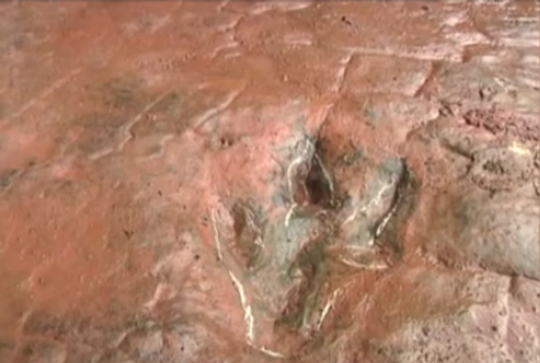Following the Footsteps of Chinese Dinosaurs
Dinosaur Tracksites Identified in Guizhou Province
Everything Dinosaur has received media reports from several Chinese news agencies reporting the discovery of extensive dinosaur tracks in Guizhou Province (south-western China). A total of sixty-eight tracks have been identified from sediments exposed in a river valley close to Tongmin Town. The largest of the prints is estimated to be nearly fifty centimetres long.
Yesterday, a field team consisting of palaeontologists from the China University of Geosciences and Guizhou Provincial Museum arrived at the site to map the tracks and to conduct a full survey of the trace fossils. In a press statement, Assistant Professor Xing Lida, (China University of Geosciences, Beijing), commented that three types of trace fossil (ichnofossils) had been recorded, suggesting that the tracks were made by three different types of dinosaur. A preliminary assessment suggest that one type of track was made by a plant-eating ornithopod, whilst the other two tracks were made by theropod dinosaurs.
One of the Theropod Tracks from the Site
Picture credit: CBS/China University of Geosciences
The photograph above shows one of the theropod footprints. The researchers have highlighted the track and indicated the toes along with the claw impressions.
Xing Lida stated:
“About three types of dinosaurs passed by here. The rock surface is quite flat and the footprints head to different directions, which means a group of dinosaurs might have come here often for water and food 100 million years ago.”
Improving Knowledge on the Late Cretaceous Chinese Dinosaurs
The tracks were made in the soft mud surrounding a lake (a potential lacustrine environment), although it is not possible to tell exactly when the impressions were made in terms of which dinosaurs passed by and when, the tracks are helping Chinese researchers to better understand the dinosaur fauna of this part of the world some 100 million years ago (Cenomanian faunal stage of the Late Cretaceous).
An in-depth analysis of the tracks is to be undertaken. The research team are confident that they will be able to measure the stride length and calculate the velocity of the dinosaurs (estimation of walking speed).
These tracks are significant, as Assistant Professor Xing explained:
“The dinosaur footprints here are well-preserved compared with those in other places in China. It would be easy to calculate the length and the speed of the dinosaurs and to know what they did in this place 100 million years ago, according to their footprints.”
In 2016, Chinese media reported the discovery of a series of dinosaur tracks at a location approximately 120 miles to the south-west of the Tongmin Town site (Bijie). These tracks, represent four individual dinosaurs and the strata that they were formed in, now part of a cliff, is also around 100 million years old. These tracks were made as dinosaurs traversed the soft, sticky mud adjacent to a lake (another potential lacustrine environment).
It is hoped that data from these two locations, representing contemporaneous fauna will help scientists to gain a better understanding of which types of dinosaurs lived in southern China during the early Late Cretaceous.
Visit the award-winning Everything Dinosaur website: Everything Dinosaur.


